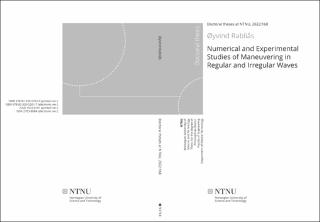| dc.description.abstract | The present work is a numerical and experimental study on maneuvering in regular and irregular waves of the Duisburg Test Case (DTC), a container ship with block coefficient CB = 0:661. Two test campaigns of free-running model tests were conducted in the Ocean Basin at SINTEF Ocean. Turning circles and Zig-Zag maneuvers are investigated in calm water, regular waves, and irregular waves. The maneuvers were tested for a range of conditions. Repetition tests are given attention in regular waves, while the stochastic variation in the same sea state is investigated in irregular waves. In addition, the spatial variation of the wave heights in the Ocean Basin is documented in two separate test campaigns.
The modular maneuvering model in Skejic (2008) is further developed in the present work. A 2D+t approach for the calculation of the transverse viscous loads is proposed. Three methods with different levels of complexity are proposed to estimate the sectional time-varying drag coefficients. The most sophisticated method, which uses time-derivatives of drag coefficients in the literature to time integrate a CD(t0) curve, performs best in general. Moreover, using time-varying drag coefficients for a circular cylinder can be a good starting point in a 2D+t approach.
The two-time scale assumption is applied for maneuvering in waves. The maneuvering model performs in general satisfactory compared to experiments. However, there are some discrepancies in following waves due to inaccurate calculation of the slowly varying second-order wave loads in following waves. A new model for the wave-modified inflow on the rudder is proposed. Methods from the literature are applied for the x-component, while the y-component is derived consistently to account for the same effects as the x-component. The effect of wave-modified inflow on the rudder is investigated for turning circles and Zig-Zag maneuvers for a range of conditions. For the shortest waves, the effect of the wave-modified inflow is almost negligible, while the effect increases with increasing wavelength.
Based on the wave documentation in the Ocean Basin, the sensitivity to the variation of wave heights during turning circles and Zig-Zag maneuvers are investigated with the modular maneuvering model. The spatial variation of the wave heights introduces a significant uncertainty for some responses, in particular for the drifting distance during turning circles, for the longest waves. However, the sensitivity is in general less than expected, and several responses are nearly unaffected.
Two approaches are implemented to calculate the slowly varying second-order waves loads in irregular waves: The widely used difference-frequency method with the Newman approximation and a time-domain method. The time-domain method is based on time series of the wave elevation, not the wave spectrum as the difference-frequency method. The two methods predict very similar results when the same realization of an irregular sea state is considered. However, for the conditions that are considered, the computational time for the time-domain method is, in average, 12.4 times faster than for the difference-frequency method. Other advantages of the time-domain method are that it is possible to use measured timeseries of the wave elevation and that it is possible to change the sea state during a maneuvering simulation. | en_US |
